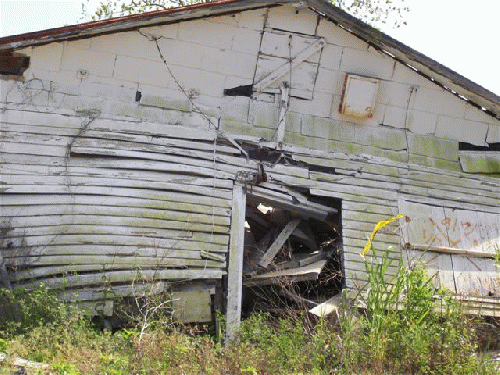Along the Gulf Coast, Post Katrina, Part 4: The Lower Ninth Ward
After wandering through Orleans Avenue (which was recounted in Part 3)Â on this increasingly warm and sunny Friday the 13th, I headed on to downtown New Orleans, somewhat disoriented by the unfamiliarity of the streets after some 28 years, but I finally found myself on the end of St. Charles Avenue. I stopped at the nearby St. Charles Bar and Pool Room and ordered a Hurricane, which I sat sipping through a straw like a slow milkshake while I watched an old Gunsmoke episode on the nearest screen. I figured I could use a good shot of rum to get me through the rest of what would surely be a taxing afternoon.
ÂI started walking up busy St. Charles, taking photos, diverting momentarily over to Camp Street, where, surprisingly, I came across the Zen Center of New Orleans, unaware that the city even had a Zen temple. It would take the compassion of Buddha, I thought, to heal all of New Orleans. I walked through Lafayette Square, photographing the statue of school children with John McDonogh, the philanthropist, also unaware that the plight of the public school system would be brutally brought home to me soon in the Lower Ninth Ward.
ÂI eventually reached Canal Street, where I bought some trinkets and took more photographs. You could never guess, looking at downtown New Orleans, that a major hurricane had devastated the city some 20 months ago. Repairs had been relatively quickly and efficiently made, even though parts of downtown had been flooded up to four feet high, as a hotel clerk explained to me. She also told me the easiest way to get to the lower Ninth: drive east on Poydras, right on Claiborne, and just keep going until you cross over a big drawbridge.
ÂSo that's what I did. However, once upon S. Claiborne and merged onto N. Claiborne, I was so struck by significant damage right on this major boulevard that I parked and took more photographs. Why, I thought, hadn't such an amazing eyesore as the one shown below been leveled after so long by the city? But again, this was in a predominantly Black district. Is that answer enough?
ÂAfter about a ten minute drive I was rolling over the large and rusty looking draw bridge spanning the Industrial Canal, the canal whose levee system had been breached in three places, two of these breaches directly flooding the Lower Ninth, a levee system that investigators have emphasized was one in name only.
ÂAs I got off the bridge, I pulled into a close by gas station, jumped out and asked a fellow gassing up to his truck if I was actually in the Lower Ninth right now, which he confirmed. "Where can I find the major damage?" I asked, explaining that I was here to take photos.
Â"Just turn right at the light two blocks up or take the next right here and start looking," he replied, "The damage is everywhere."
ÂSo I turned right, or north, and began what became a two hour plus sojourn up and down the still devastated streets of the Lower Ninth Ward, where some 25,000 people once lived, worked, played and worshipped. On the northside at least, very few people have moved back in. You see a few operable-looking cars parked in front of a few houses, as opposed to the hundreds of abandoned cars all over the place. On the southside, less badly hit, several thousand people have moved back in I am told, and I did see more people out and about, although, due to time constraints, I focused primarily on the northside, where I barely saw a person all afternoon, except for a few city workers, several homeowners, and a handful of contractors, that is until I went by the Common Ground Community Center later on.
(Note: You can view every article as one long page if you sign up as an Advocate Member, or higher).






